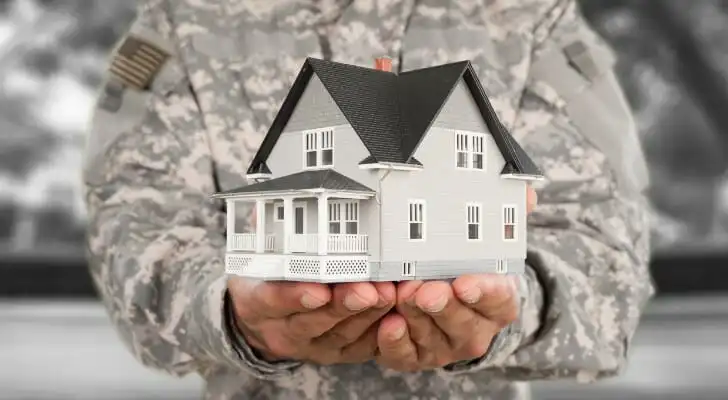Housing assistance is one of the most significant benefits for members of the U.S. military. When a base offers housing in remote stations it can provide the kind of stable community that civilian housing may not. In crowded regions like California, on the other hand, on-base housing can offer military personnel options they otherwise couldn’t afford. For these reasons, retirees might be looking to continue those housing benefits but aren’t sure what to do. The government does offer housing options for military retirees, and here’s how it works.
A financial advisor can help retired veterans manage housing, pensions, Social Security and other parts of their retirement plan.
Military Housing Overview
Military housing has traditionally been viewed as a valuable benefit for those who serve or pursue long-term careers in the armed forces. These housing options include living on a military base or using private sector housing while receiving a monthly housing allowance through the Department of Defense.
Members of the military who are stationed on a U.S. base generally have two housing options:
1. Military Housing Allowance
The Department of Defense increasingly relies on private sector housing supported by the Basic Allowance for Housing (BAH). Under this program, eligible service members assigned to domestic duty stations receive a monthly allowance to help cover rent or mortgage costs near their base.
The BAH amount is based on three main factors: local housing costs, the service member’s pay grade, and dependent status. Those who live off base and are not provided government housing typically receive this stipend. When combined with VA-backed mortgage options, BAH has contributed to increased homeownership among service members. Service members assigned to on-base housing that is government-furnished do not receive BAH.
2. On-Base Housing
Service members may also qualify for housing directly on base. While traditional barracks are still used—especially for junior enlisted personnel—many installations now offer townhouse-style or single-family housing that resembles civilian neighborhoods.
Eligibility for on-base housing depends on factors such as pay grade, family status, housing availability, and date of assignment. Bases assign housing using priority categories, often giving preference to married personnel and those with dependents. Single service members typically live in barracks or unaccompanied housing, especially if they are in lower pay grades.
Demand for on-base housing varies widely. Some installations have long waiting lists, while others with surplus housing may make it available to Other Eligible Tenants (OET), including retirees and DoD civilians. In such cases, local civilians may also be offered housing if military demand remains low. Personnel living in government-provided housing generally do not receive BAH.
Military Retiree Housing Policies
All of this leads back to the original question: Once you have retired from the military can you still qualify for housing? Let’s take a look at how each of the two options now work if you’re retired.
Military Housing Allowance
After retiring, you will no longer receive a Basic Allowance for Housing. Military retirement pensions are calculated using base pay and do not incorporate benefits such as the BAH.
Access to On-Base Housing
Military retirees can apply for on-base housing, but only if there is extra space after all active duty service members are housed. The Department of Defense gives priority to active duty personnel. If homes are still available, the base may open applications to “Other Eligible Tenants” (OETs).
Retirees are in Tier B of the OET list. They can only apply if the base has been less than 95% occupied for more than 30 days. Tier A applicants, like active military and National Guard members and their families, are considered first. This means retirees can get housing, but only after all Tier A requests are handled and space remains.
Veterans Affairs Home Loans
The VA also offers several programs to make home loans more accessible to veterans, which can be an alternative to finding and qualifying for military housing.The most common option involves the VA’s low-cost, low (or no) down payment mortgages. Through this program the VA helps veterans secure home loans below market rates.
The agency also runs what are known as adapted housing grants. These help veterans with disabilities to purchase adapted housing or modify their current housing around their needs. These programs have their own eligibility requirements, so the details will vary based on personal finances, length of service and nature of service. Buying a house can be one of the best investments you ever make and these loans can be a helpful tool to get you there.
Senior-Living Communities for Military Retirees

There are a few retirement communities with large numbers of residents who used to serve in the military, such as Falcons Landing in Potomac Falls, VA and Air Force Enlisted Village in Shalimar, FL. This is mostly due to their location because they are typically close to military hospitals, VA hospitals, or military bases.
Most are open to the public but are primarily made up of ex-military because of how close they are to needed military services. Retired veterans are also eligible to apply for housing 1 through the Armed Forces Retirement Home program. It includes two facilities, one in Washington D.C. and one in the Gulf Coast area of Mississippi.
Housing Alternatives for Retired Veterans
Once military retirees leave active service, they lose access to the Basic Allowance for Housing and may find on-base housing limited or unavailable. For those looking beyond these traditional options, there are several alternatives worth considering:
- VA-backed mortgages: Retired veterans can use the U.S. Department of Veterans Affairs (VA) loan program to buy a home with no down payment, no private mortgage insurance (PMI), and competitive interest rates. These loans are reusable and can be applied to new home purchases or refinancing, making them a flexible option for long-term homeownership.
- State and local veteran housing programs: Many states and counties offer property tax exemptions, subsidized mortgage programs, or veteran-designated housing assistance. These programs vary by location and eligibility, but they can help retired veterans lower their long-term housing costs, especially in high-cost areas.
- Civilian housing with military ties: In some areas near military bases, developers may offer discounted housing or partnerships with veteran service organizations. While not guaranteed, these arrangements can provide both financial support and access to veteran-focused services in civilian communities.
- Retirement communities with veteran networks: Some retirement communities are not officially affiliated with the military but are popular among veterans due to proximity to VA hospitals, veteran peer support, or participation in healthcare programs. These communities may offer a shared environment that appeals to former service members.
- Cooperative living or shared housing: Veteran nonprofits and local charities sometimes offer shared housing or cooperative living arrangements for older veterans. These setups can help lower housing costs and reduce social isolation, particularly for retirees living on fixed incomes.
- Assisted living and long-term care options: Some assisted living and nursing care facilities offer priority placement or financial assistance to eligible veterans. These services may be supported by VA Aid and Attendance benefits, which can help cover the costs of daily care for veterans who meet the program’s requirements.
Bottom Line
If you’re a veteran and want to secure military housing, it is possible. After retiring from the military, you can no longer receive the Basic Allowance for Housing (BAH), but you can apply for on-base housing. You will have priority over civilian candidates but will be behind active duty service members, National Guard families, and some Department of Defense (DoD) personnel. You can also look into U.S. Department of Veterans Affairs (VA) loan programs for veterans.
Tips for Retirement Planning
- Choosing where to live after military service can be challenging. A financial advisor can help you make decisions about your Thrift Savings Plan (TSP), when to retire, and how these choices affect your long-term finances. Finding a financial advisor doesn’t have to be hard. SmartAsset’s free tool matches you with vetted financial advisors who serve your area, and you can have a free introductory call with your advisor matches to decide which one you feel is right for you. If you’re ready to find an advisor who can help you achieve your financial goals, get started now.
- If you’re a veteran looking to transition into civilian life, some places may be more comfortable than others. Check out our study on the best states for veterans.
Photo credit: ©iStock.com/artisteer, ©iStock.com/asiseeit, ©iStock.com/Bill Chizek
Article Sources
All articles are reviewed and updated by SmartAsset’s fact-checkers for accuracy. Visit our Editorial Policy for more details on our overall journalistic standards.
- Armed Forces Retirement Home. https://www.afrh.gov/apply.

